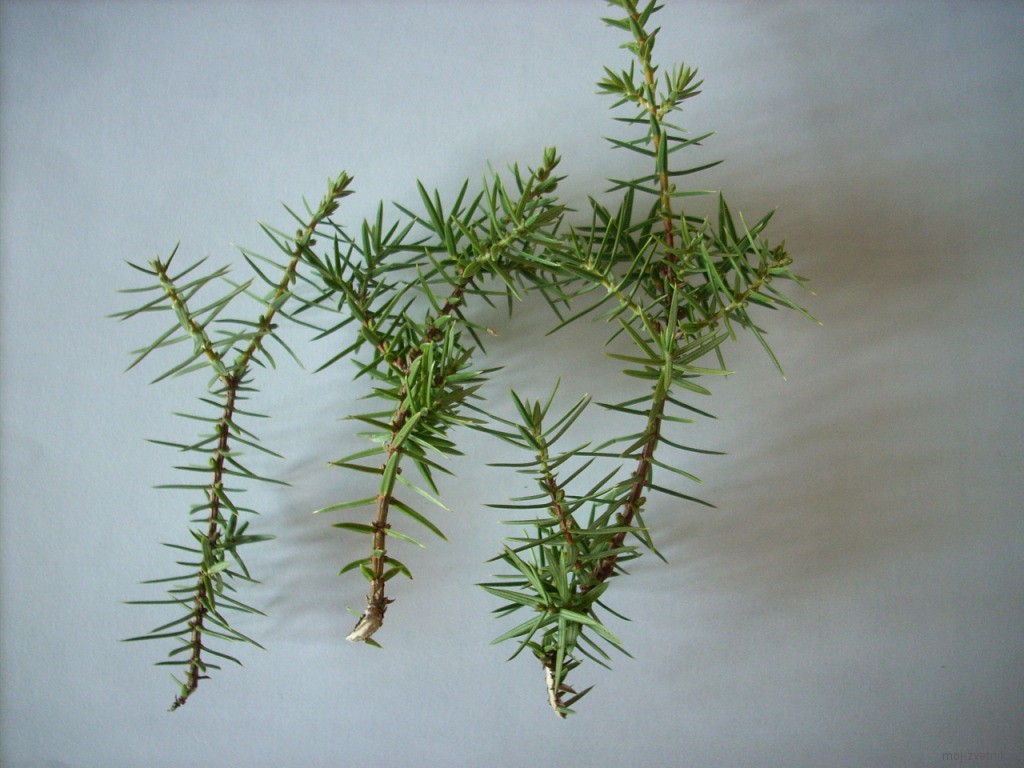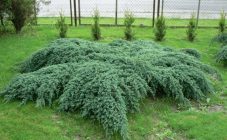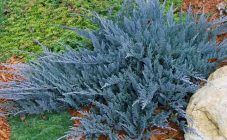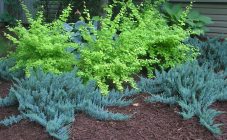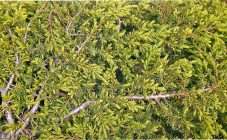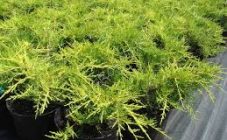Content:
Coastal juniper (Juniperus conferta) is a flat-growing, dwarf shrub. Introduced into cultivation since 1915, it is considered a difficult species to cultivate. Forms a thick, prickly, bright carpet that effectively stands out against the background of other conifers. Juniper genus, coniferous class, cypress family, confert species (coastal).
A dioecious plant, propagated by seeds, less often by vegetative means. As a representative of the cypress family, he loves light and warmth, but at the same time has an enviable resistance to climatic "oddities", most varieties successfully tolerate frost and drought.
Description of the variety
This is a creeping, creeping shrub, the maximum height is 2 meters, while by the age of 10 the plant does not exceed 20 cm, the crown diameter reaches 1 m. Branches are red-brown in color, cones are dark blue, round, with a bluish bloom. Leaves are needle-like, flattened, 10-15 mm long, 1 mm wide. The needles are gray-green, dark green, with prickly tips.
Annual growth averages 3 cm in height and 5 cm in spread.
Characteristics of the main varieties:
- juniper coastal conferta Schlyager;
- junior blue lagoon;
- juniper sweater Golden Wings;
- Blue Pacific conference;
- Emerald Sea conference;
- All Gold coastal juniper;
- Silver Mist.
Juniper Blue Lagoon - Discovered in 1976 by Dr. John L. Creech with the gardener Sylvester G. in a Japanese arboretum. Since 1992 it has been sold freely. It has a ground cover, masculine, creeping form. On average, it grows up to 15 cm. In summer, the needles have a bluish-green color, in winter they add a plum shade.
Juniper Golden Wings is an unusual variegated form with yellow-green needles. A low shrub up to 20 cm tall, with creeping branches slightly rising at the tips. The bark is red-brown or brown, old branches are brown-gray in color. Leaves are linear-lanceolate, 3.8-15 mm in length and up to 1-1.7 mm in width, straight, prickly. Large cones berries, up to 14 mm in diameter, blue-black when ripe.
Juniper Emerald Sea (Emerald Sea) has a creeping, spreading crown, branches are long, the root system is not deep. Height - up to 30 cm, crown diameter - up to 2-2.5 m. The needles are bluish-green, slightly prickly, slightly yellow in winter. Frost-resistant variety, not picky about the soil, poorly tolerates stagnant moisture and soil compaction.
Juniper Hit, according to the description, is a sprawling, slowly growing shrub with long, green needles with a light blue stripe. Undemanding to soil and moisture, it is recommended for planting in rocky gardens and rock gardens, as a ground cover plant. The height of the bush does not exceed 30-40 cm, the crown diameter is up to 1.5 m.
Juniper coastal blue pacific - miniature shrub, with shoots creeping along the ground (30 cm in height and up to 2 m in diameter). The foliage is long, prickly, bluish-green in color. Shoots are hard and dense. Numerous black berries with a bluish bloom, vaguely reminiscent of blueberries. It is frost-resistant, gives priority to sunny places.
Juniper coastal All Gold - a small, compact, evergreen shrub, up to 20 cm in height and 90 cm in crown diameter.It grows relatively quickly: in a year up to 10 cm in height and 20 cm in width. Chaotic branches, long, flat asymmetrical crown. The needles are thin, long, shiny, yellowish-green in color.
Silver Mist (Silver Mist) - creeping coniferous shrub, not exceeding 30 cm in height, crown diameter - not more than 90 cm. Moderately long skeletal branches branch strongly and chaotically. The needles are gray-blue with a silvery sheen. Prefers open sunny areas, not picky about the ground.
Plant propagation
You can propagate juniper by seeds, semi-lignified cuttings and layering.
The coastal juniper prefers sunny locations, little shading is allowed. In full shade, shrubs grow loose, losing their decorative qualities.
The soil is selected with a neutral or slightly acidic reaction. It grows absolutely on any substrate (limestone, rocky slopes), but prefers light soils, sandy, loam.
Seed propagation is used for the main species, while varietal characteristics are almost completely not inherited. Freshly harvested seeds are subject to sowing for the winter, since after 1-2 years of storage, germination is reduced to zero. The seeds are removed from the fruit, washed with clean water and chemical scarification is carried out (impact on the hard shell with concentrated sulfuric acid for 30 minutes). Seedlings will appear in the spring.
Planting seeds in spring implies a mandatory two-stage stratification: pre-washed seeds are mixed with moistened sand or sphagnum moss, placed in a plastic bag and placed in a place with a temperature of + 20-30 degrees for 2-3 months, then this indicator is lowered to +3 -5 degrees and stored for up to 4 months. In the spring, seeds are sown in open ground or in special boxes (t + 18-23 ° C). Seedlings sprout in at least a year or two.
Purchased seedlings are planted using the following nuances:
- the distance between plantings is at least 50-200 cm;
- the planting hole is dug with a reference point on the earthen clod of the seedling, at least twice its size, the depth is 50-70 cm;
- a drainage layer of broken brick, sand - up to 20 cm;
- the root collar is not buried;
- the soil for filling the pit is prepared from sand, humus and sod land, in proportions 1: 2: 2
Propagation by cuttings:
- spring cuttings taken from short side shoots before bud awakening, the presence of a "heel" is mandatory;
- rooting is carried out at 15-18 degrees of heat.
Reproduction by layering does not guarantee the preservation of the crown characteristic of the species; rooting occurs within a year.
Culture care
Caring for a juniper is quite simple, watering is minimized, feeding for adult plants is not required at all.
Watering
After planting, the juniper is generously watered for a week. In a dry summer, it is advised to water 2-3 times per season, sprinkle a couple of times a week in the evening hours.
Loosening, mulching, weeding
Surface loosening is envisaged, immediately after irrigation. Weed weeding is carried out systematically. Mulch with peat, sawdust or chips, a layer of 5-8 cm, after planting, for thermophilic varieties of coastal juniper additional mulching is carried out for the winter.
Top dressing
Necessary only for young plants. In the spring (April, May), they are enriched with nitroammophos (30-40 g per sq./m) or with fertilizers specifically for conifers.
Pruning
Coastal juniper grows very slowly, so it is advisable to carry out a weak sanitary cutting.
Shelter for the winter
Juniper Konferta has high frost resistance, only planted plants are covered in the first year of existence, using spruce branches.
Diseases and pests
Despite the high resistance to diseases and pests, plant damage is possible:
- fusarium;
- rust;
- drying out of juniper branches;
- alternaria;
- brown shute;
- bark necrosis.
For the purpose of treatment and prevention, treatment with fungicides or copper-containing agents is used.
Of the pests, the following are especially distinguished:
- spider mite;
- juniper miner moth;
- aphids;
- juniper scale.
Landscape
The coastal juniper forms a thick, thorny carpet that stands out vividly against the background of other conifers. The peak of decorativeness is observed at the beginning of the summer season, when young shoots grow back.
In landscape design, it is used as a tapeworm against the background of a lawn, serves as a decoration for the territories of administrative buildings and private gardens. Perfectly goes for an unusual yellow-green carpet, complements park compositions, alpine slides and rockeries. Junipers are used as hedges, terraces, roofs, loggias and balconies are planted with them.
Juniper is one of the most undemanding garden plants: beautiful all year round, durable, decorates the design for decades, does not require special care. The cultivation of any coastal juniper will make it possible not only to decorate the landscape of the garden plot, but also to obtain a powerful drug that helps against many diseases.


